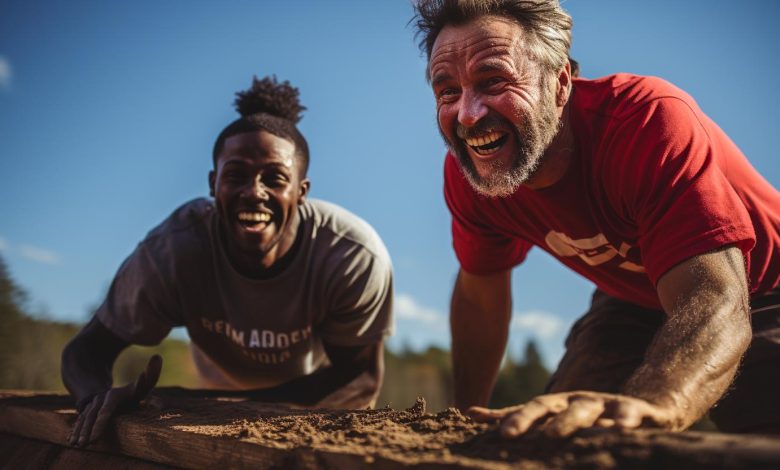Preventing Common Injuries in High-Impact Sports

Did you know that over 2 million people suffer from sports-related injuries every year? If you love high-impact sports, it’s crucial to prioritize injury prevention.
This article will provide you with valuable information on how to avoid common injuries in these intense activities. From warming up and stretching properly to using the right technique and protective gear, we’ll guide you through the necessary steps.
Additionally, we’ll explore injury prevention exercises and training programs to keep you at the top of your game.
Types of Injuries in High-Impact Sports

In high-impact sports, it’s important to be aware of the types of injuries that can occur. These sports involve intense physical activity and require athletes to make quick, forceful movements. As a result, there is an increased risk for certain types of injuries.
One common type of injury in high-impact sports is a sprain or strain. These occur when the ligaments or muscles are stretched beyond their normal range of motion. Sprains usually affect the joints, such as the ankle or wrist, while strains typically occur in muscles like the hamstring or quadriceps.
Another frequent injury is fractures. High-impact sports put significant stress on bones, making them more susceptible to breaks. Fractures can range from minor hairline cracks to complete breaks and may require immobilization and rehabilitation.
Concussions are also a concern in these sports. A concussion occurs when there is a blow to the head that causes temporary brain dysfunction. Symptoms may include headache, dizziness, confusion, and memory problems.
To prevent these injuries, it’s important to implement injury prevention strategies. This includes wearing proper protective equipment like helmets and pads, maintaining good physical conditioning, using correct techniques when performing skills or tackles, warming up before engaging in intense activity, and listening to your body by resting and recovering properly after training sessions or games.
Importance of Warm-Up and Stretching

Before engaging in high-impact sports, it’s crucial to warm up and stretch to prevent potential harm. Dynamic stretching is an effective warm-up technique that involves moving your muscles through their full range of motion. Unlike static stretching, where you hold a stretch for a prolonged period, dynamic stretching helps increase blood flow and muscle temperature, preparing your body for the demands of the sport.
Dynamic stretching offers several benefits. Firstly, it improves flexibility and joint mobility by increasing the range of motion in your muscles. This allows you to move more freely during physical activity, reducing the risk of strains or tears. Secondly, dynamic stretches activate and engage multiple muscle groups simultaneously, enhancing coordination and balance. These exercises also increase heart rate and stimulate neural pathways, priming your body for optimal performance.
While warm-up exercises are essential for injury prevention, rest and recovery play a vital role as well. Giving your body time to recuperate after intense training sessions or matches allows tissues to repair themselves and adapt to the stress placed upon them. Adequate rest not only reduces fatigue but also prevents overuse injuries such as tendinitis or stress fractures.
Proper Technique and Form

Proper technique and form are crucial for maximizing performance and reducing the risk of harm in high-impact sports. When it comes to preventing common injuries, here are four essential tips:
1. Maintain proper body alignment: Incorrect posture can increase the strain on your muscles and joints, leading to injuries. Focus on keeping your spine neutral and aligning your body correctly during movements.
2. Use controlled movements: Avoid sudden jerky motions as they can put excessive stress on your joints and muscles. Instead, perform smooth, controlled movements that engage the appropriate muscle groups.
3. Gradually increase intensity: Pushing yourself too hard or progressing too quickly can lead to overuse injuries. Gradually increase the intensity of your workouts or training sessions to allow your body time to adapt and strengthen.
4. Seek professional guidance: Working with a qualified coach or trainer who understands proper technique is invaluable for injury prevention. They can help correct any mistakes you may be making and provide personalized guidance tailored to your sport.
By following these injury prevention tips, you’ll reduce the likelihood of getting hurt while improving your performance in high-impact sports.
Now, let’s delve into another crucial aspect of staying safe on the field – protective gear and equipment.
Protective Gear and Equipment

Using the right protective gear and equipment is essential for staying safe during high-impact sports. When it comes to head injuries, wearing proper headgear is of utmost importance. Headgear such as helmets can help absorb the impact of a collision or fall, reducing the risk of serious head trauma. They are designed with materials that provide cushioning and support, offering protection to the skull and brain.
Mouthguards also play a significant role in preventing injuries in high-impact sports. They act as a barrier between the upper and lower teeth, absorbing the force from blows to the face or jaw. Mouthguards not only protect teeth from being knocked out but also reduce the risk of jaw fractures and soft tissue damage.
It is crucial to choose headgear that fits properly and meets safety standards specific to your sport. Ill-fitting gear may impair visibility or restrict movement, increasing the chances of accidents. Similarly, mouthguards should be custom-made or boil-and-bite types that mold to your teeth for optimal protection.
Injury Prevention Exercises and Training Programs

Make sure you incorporate injury prevention exercises and training programs into your routine to keep yourself safe while participating in high-impact sports. The following strategies will help reduce the risk of injuries and improve your performance:
1. Dynamic Warm-Up: Start your workout with a dynamic warm-up that includes movements specific to your sport. This will increase blood flow, loosen up muscles, and prepare your body for the demands of the activity.
2. Strength Training: Building strength is crucial for injury prevention. Focus on exercises that target the muscles commonly used in your sport, such as squats, lunges, and deadlifts. Include both upper and lower body exercises to maintain balance and stability.
3. Plyometrics: Incorporate plyometric exercises into your training program to improve power and agility. These explosive movements, like box jumps or medicine ball throws, can enhance muscle coordination and reduce the risk of sprains or strains.
4. Flexibility Training: Stretching before and after workouts can enhance flexibility and prevent muscle imbalances that may lead to injuries. Incorporate static stretches into your cool-down routine to improve joint range of motion.
Conclusion
In conclusion, by implementing proper warm-up routines and utilizing protective gear, you can greatly decrease the risk of common injuries in high-impact sports. Focusing on technique and form, as well as engaging in injury prevention exercises and training programs, are also crucial in preventing injuries. Remember to stay vigilant and committed to these practices to ensure a safe and successful athletic journey.
Soothe your soul with strategic safety steps!






